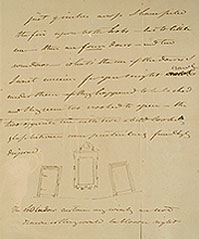


Brunel sketch for a hotel design
(University of Bristol)

ss Great Britain (ss Great Britain Trust)


Details of page from letter home to
Mary Horsley showing draughty
doors and windows in Wooton
Bassett hotel room
(University of Bristol)






The
1830s
In 1832, Brunel began his association with the Bristol Docks Company where
he was engaged with schemes for improving and modernising the facilities
for the next 15 years.
He was engaged in other dock engineering projects over the years including
Plymouth, Brentford and Milford Haven, and in the railway at Cardiff Docks.
(Read more about the docks on the Bristol
Docks page).
In March 1833, Brunel was appointed chief engineer of the newly formed
Great Western Railway and started surveying the route from London to Bristol.
He had no previous experience in railway engineering but the directors
were impressed by his enthusiasm and self-assurance. He had made his first
journey by train on 5 December 1831 and wrote in his diary, alongside
a series of wavering lines and circles:
I record this specimen of the shaking on Manchester railway. The time
is not far off when we shall be able to take our coffee and write while
going noiselessly and smoothly at 45 miles per hour – let me try.
The Second Great Western Railway Bill was passed in August 1835 and Brunel’s
proposal to use a broad gauge system, which he felt would provide faster
and smoother journeys, was accepted in October. That same year Brunel
was appointed engineer for the Cheltenham & Great Western Union, Bristol
& Exeter, Bristol & Gloucester, and Merthyr & Cardiff railways.
He would hold many engineering appointments with various railway companies
during his career, including projects in Italy and India. He was usually
involved in every detail of their construction: not just the route, track
and engines, but also the architecture of the stations, the colour of
the livery and the decorative details. He would often be engaged in a
number of major projects at any one time, adding to the pressures upon
him but satisfying his love of work. The London-Bristol section of the
Great Western route was opened on 30 June 1841. (Read more about the Great
Western Railway on the Great Western
Railway page).

Interior of Temple Meads (National
Trust)

Brunel plan and elevation for Paddington station (University
of Bristol)
In 1836, Brunel was appointed engineer of the Great Western
Steamship Company and work began in Bristol on his first ship design –
ss Great Western, a paddle steamer. The ship formed part of a proposed
integrated transport system that would bring people from London to Bristol
by train, to the dockside by coach and to New York by steamship. The hull
was launched on 19 July 1837 and work commenced that same year on building
the Royal Western Hotel to accommodate passengers. Great Western’s
maiden trans-Atlantic voyage in 1838 took 15 days. Construction began
on a sister ship, the ss Great Britain, in 1839 at the Great Western Dockyard.
Following a distinguished but occasionally ill-fated career, the ship
returned to Bristol in 1970 and is now one of the icons of the city. (Read
more about the ss Great Western and ss Great Britain on the ss
Great Britain page).

ss Great Western (Private collection)
On 5 July 1836, Brunel married Mary Horsley and the couple set up home
at 18 Duke Street, Westminster. They had three children: Isambard, who
became a lawyer and his father’s biographer; Florence Mary who married
a teacher at Eton; and Henry Marc, who became an engineer. His friend
and colleague William Dawes had introduced Brunel to the Horsley family
in 1832, and he had often visited their home where he enjoyed amateur
theatricals, charades, music and oratories in his rare moments of leisure.
Brunel had had a number of romantic interludes but had always declared
that he would only marry a woman with money and musical talent. As Mary
had neither and, it has been said, had ‘nothing to be proud of but
her face’ it can be assumed that Brunel married for love. Mary would
become a popular hostess, entertaining the cream of fashionable London
society at their home and providing what Adrian Vaughan has described
as ‘an oasis of culture’ for Brunel to occasionally return
to. Her brother, the artist John Horsley, was a close friend of Brunel
and painted his portrait.
